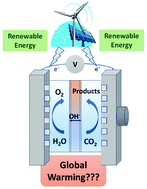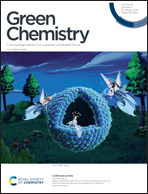Comparative life cycle assessment of electrochemical upgrading of CO2 to fuels and feedstocks†
Abstract
Development of electrochemical pathways to convert CO2 into fuels and feedstock is rapidly progressing over the past decade. Here we present a comparative cradle-to-gate life cycle assessment (LCA) of one and two-step electrochemical conversion of CO2 to eight major value-added products; wherein we consider CO2 capture, conversion and product separation in our process model. We measure the carbon intensity (i.e., global warming impact) of one and two-step electrochemical routes with its counterparts – thermochemical CO2 utilization and fossil-fuel based incumbent synthesis routes for those eight products. Here we show that due to inevitable carbonate formation or CO2 crossover in one-step CO2 electrolysis using neutral pH membrane electrode assembly, the two-step electrosynthesis pathways (i.e., CO2 to CO in solid oxide electrolysis cell followed by CO electroreduction in alkaline flow cell) would be distinctively compelling through the lens of climate benefits. This analysis further reveals that the carbon intensity of electrosynthesis products is due to significant energy requirement for conversion (77–83% of total energy consumption for gas products) and product separation (30–85% of total energy consumption for liquid products) phases. Global warming impact of electrochemical route is highly sensitive to the electricity emission intensity and is compelling over incumbent routes only when coupled with low emission intensity (<0.25 kg CO2e per kWh). As the technology advances, we identify near-term compelling products that would provide climate benefits over incumbent routes, including syngas, ethylene and n-propanol. We further identify technological goals required for electrochemical route to be competitive, notably achieving liquid product concentration >20 wt%. It is our hope that this analysis will guide the CO2 electrosynthesis community to target achieving these technological goals, such that when coupled with low-carbon electricity, electrochemical route would bring climate benefits in near future.



 Please wait while we load your content...
Please wait while we load your content...